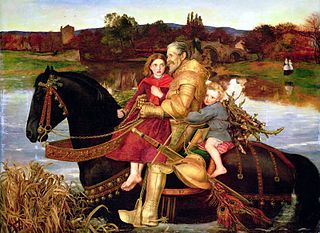 W
WThe Lady Lever Art Gallery is a museum founded and built by the industrialist and philanthropist William Lever, 1st Viscount Leverhulme and opened in 1922. The Lady Lever Art Gallery is set in the garden village of Port Sunlight, on the Wirral and one of the National Museums Liverpool.
 W
WThe Beguiling of Merlin is a painting by the British Pre-Raphaelite painter Edward Burne-Jones that was created between 1872 and 1877.
 W
WThe Black Brunswicker (1860) is a painting by John Everett Millais. It was inspired in part by the exploits of the Black Brunswickers, a German volunteer corps of the Napoleonic Wars, during the Waterloo campaign and in part by the contrasts of black broadcloth and pearl-white satin in a moment of tender conflict.
 W
W"The Blessed Damozel" is perhaps the best known poem by Dante Gabriel Rossetti as well as the title of some of his best known paintings. The poem was first published in 1850 in the Pre-Raphaelite journal The Germ. Rossetti subsequently revised the poem twice and republished it in 1856, 1870 and 1873.
 W
WBubbles, originally titled A Child's World, is an 1886 painting by Sir John Everett Millais that became famous when it was used over many generations in advertisements for Pears soap. During Millais's lifetime it led to widespread debate about the relationship between art and advertising.
 W
WCromwell on his Farm (1874) is a painting by Ford Madox Brown which depicts Oliver Cromwell observing a bonfire on his farm and thinking of a passage in the Book of Psalms: "Lord, how long wilt thou hide thyself - forever? And shall thy wrath burn like fire?". The words are inscribed on the painting's frame along with a quotation from one of Cromwell's speeches, in which he describes his life before entering into politics: "living neither in any considerable height, nor yet in obscurity, I did endeavour to discharge the duty of an honest man."
 W
WA Dream of the Past: Sir Isumbras at the Ford (1857) is a painting by John Everett Millais depicting a medieval knight helping two young peasant children over a swollen river. The children are carrying heavy burdens of wood for winter fuel. Though the title refers to the medieval poem Sir Isumbras, the painting does not illustrate a scene from the original text. However Millais's friend, the writer Tom Taylor, wrote verse in a pastiche of the original poem, describing the event depicted. This was included in the original exhibition catalogue.
 W
WThe Last Muster is an 1875 oil painting by Sir Hubert von Herkomer, based on his wood engraving Sunday at the Chelsea Hospital published in The Graphic on 18 February 1871. The painting is in the Lady Lever Art Gallery in Liverpool.
 W
WThe Scapegoat (1854–1856) is a painting by William Holman Hunt which depicts the "scapegoat" described in the Book of Leviticus. On the Day of Atonement, a goat would have its horns wrapped with a red cloth – representing the sins of the community – and be driven off.
 W
WThe Triumph of Cleopatra, also known as Cleopatra's Arrival in Cilicia and The Arrival of Cleopatra in Cilicia, is an oil painting by English artist William Etty. It was first exhibited in 1821, and is now in the Lady Lever Art Gallery in Port Sunlight across the River Mersey from Liverpool. During the 1810s Etty had become widely respected among staff and students at the Royal Academy of Arts, in particular for his use of colour and ability to paint realistic flesh tones. Despite having exhibited at every Summer Exhibition since 1811 he attracted little commercial or critical interest. In 1820 he exhibited The Coral Finder, which showed nude figures on a gilded boat. This painting attracted the attention of Sir Francis Freeling, who commissioned a similar painting on a more ambitious scale.